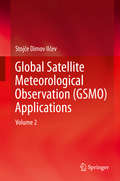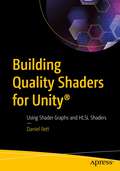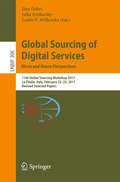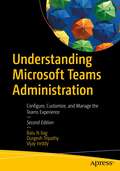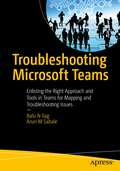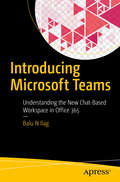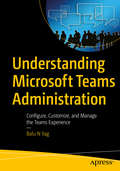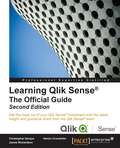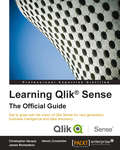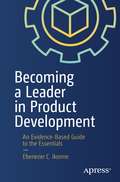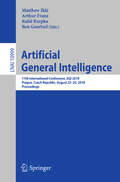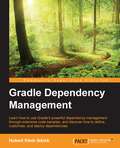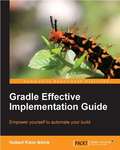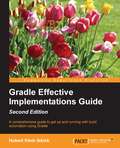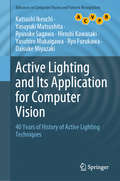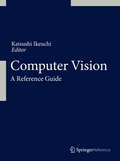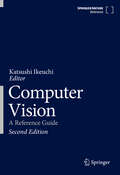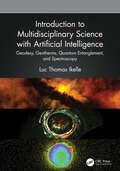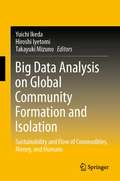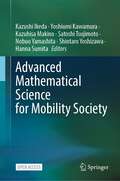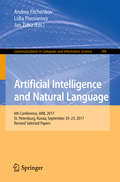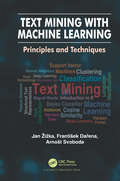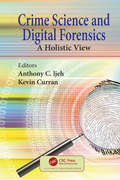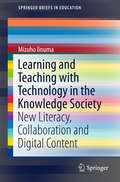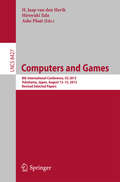- Table View
- List View
Global Satellite Meteorological Observation (GSMO) Applications: Volume 2
by Stojče Dimov IlčevThis book presents principal structures of space systems functionality of meteorological networks, media and applications for modern remote sensing, transmission systems, meteorological ground and users segments and transferring weather data from satellite to the ground infrastructures and users. The author presents techniques and different modes of satellite image interpretation, type of satellite imagery, spectral imaging properties, and enhancement of imaging technique, geo-location and calibration, atmospheric and surface phenomena. Several satellite meteorological applications are introduced including common satellite remote sensing applications, weather analysis, warnings and prediction, observation and measurements of meteorological variables, atmosphere and surface applications, ocean and coastal applications, land, agriculture and forestry applications, and maritime and aviation satellite weather applications. The author also covers ground segment and user segment in detail. The final chapter looks to the future, covering possible space integrations in meteorological and weather observation.This is a companion book of Global Satellite Meteorological Observation Theory (Springer), which provides the following topics:Evolution of meteorological observations and history satellite meteorologySpace segment with satellite orbits and meteorological payloadsAnalog and digital transmission, type of modulations and broadcasting systemsAtmospheric radiation, satellite meteorological parameters and instrumentsMeteorological antenna systems and propagation
Building Quality Shaders for Unity®: Using Shader Graphs and HLSL Shaders
by Daniel IlettUnderstand what shaders are and what they’re used for: Shaders are often seen as mystical and difficult to develop, even by skilled programmers, artists, and developers from other game design disciplines. This book dispels that idea by building up your shader knowledge in stages, starting with fundamental shader mathematics and how shader development mindset differs from other types of art and programming, and slowly delves into topics such as vertex and fragment shaders, lighting, depth-based effects, texture mapping, and Shader Graph.This book presents each of these topics with a comprehensive breakdown, the required theory, and some practical applications for the techniques learned during each chapter. The HLSL (High Level Shading Language) code and Shader Graphs will be provided for each relevant section, as well as plenty of screenshots.By the end of this book, you will have a good understanding of the shader development pipeline and you will be fully equipped to start making your own aesthetic and performant shader effects for your own games!You Will Learn To• Use shaders across Unity’s rendering pipelines• Write shaders and modify their behavior with C# scripting• Use Shader Graph for codeless development• Understand the important math behind shaders, particularly space transformations• Profile the performance of shaders to identify optimization targetsWho Is This Book ForThis book is intended for beginners to shader development, or readers who may want to make the jump from shader code to Shader Graph. It will also include a section on shader examples for those who already know the fundamentals of shaders and are looking for specific use cases.
Global Sourcing of Digital Services: 11th Global Sourcing Workshop 2017, La Thuile, Italy, February 22-25, 2017, Revised Selected Papers (Lecture Notes in Business Information Processing #306)
by Ilan Oshri, Julia Kotlarsky and Leslie P. WillcocksThis book constitutes revised selected papers from the 11th international Global Sourcing Workshop 2017, held in La Thuile, Italy, in February 2017. The 10 contributions included were carefully reviewed and selected from 45 submissions. The book offers a review of the key topics in sourcing of services, populated with practical frameworks that serve as a tool kit to students and managers. The range of topics covered in this book is wide and diverse, offering micro and macro perspectives on successful sourcing of services. Case studies from various organizations, industries and countries are used extensively throughout the book, giving it a unique position within the current literature offering.
Understanding Microsoft Teams Administration: Configure, Customize, and Manage the Teams Experience
by Balu N Ilag Durgesh Tripathy Vijay IreddyThis book provides solutions, best practices, tips, and workarounds to plan, design, customize, implement, and manage Microsoft Teams in any environment. This revised edition has been updated to reflect all the latest techniques and products, including migration from Skype for Business On-Prem to Microsoft Teams, along with Teams for Education, which includes a range of features and tools that enable teachers and students to collaborate, communicate, and learn in a virtual environment.The book begins with an overview of Microsoft Teams, including its architecture, teams/channels, audio/video meetings, and the phone system. The authors then take you deeper into deployment and management of teams, clients, guests and external access, and live events, followed by a walk-through of network assessment and bandwidth planning for Teams. Here, you will learn about deployment of quality of service and how to configure your phone systems using direct routing and calling plans. Moving forward, you will learn Microsoft Teams administration and policy management along with the migration process of Skype from Business On-Prem to Microsoft Teams. To wrap things up, the authors demonstrate some troubleshooting techniques for call quality issues in Teams, and walk you through various features of Teams for Education and how to utilize them. By the time you turn the last page of Understanding Microsoft Teams Administration, you'll be fully equipped to configure, customize, and control Teams with confidence. Don't just adapt to the future of collaboration—lead it. What You Will Learn Kickstart your journey: Get acquainted with the Teams architecture, from teams and channels to audio/video conferencing and beyondMaster the mechanics: Dive deep into deployment, including crucial aspects like guest access, such as events, and network assessmentElevate call quality: Learn the nuts and bolts of Quality of Service (QoS) and phone systems, including direct routing and calling plansAdmin like a pro: Gain insights into robust policy management, and understand how to navigate the Teams admin portal with finesseGet a grip on network assessment and bandwidth planning tailored specifically for TeamsUnlock secrets of quality of service, direct routing, and customized calling plansMigration simplified: Seamlessly shift from Skype for Business On-Prem to Teams without missing a beatEdu-tech unveiled: Explore Teams for Education and how its myriad features can enrich virtual learning experiences for teachers and students alikeWhat's new: A dedicated chapter exclusively covering Microsoft Teams for Education, focusing on empowering both educators and studentsWho This Book Is For Administrators and technical consultants focused on Microsoft Teams. This book serves as an invaluable resource for those looking to optimize team collaboration and communication within their organizations.
Troubleshooting Microsoft Teams: Enlisting the Right Approach and Tools in Teams for Mapping and Troubleshooting Issues
by Balu N Ilag Arun M SabaleLearn and understand Microsoft Teams functionality, potential issues, and the tools available to troubleshoot Teams. This book provides a complete overview of Teams Phone system (PSTN) connectivity, call routing and quality troubleshooting, and best practices to support a Teams environment.The book begins with an introduction to Microsoft Teams and it provides a troubleshooting terminology. You will understand how to identify and develop a systematic approach for troubleshooting Teams. You will learn Teams Phone (voice) management and how to handle issues related to: Direct Routing connectivity, call routing, emergency calling, and much more. The book covers issues related to Teams client-side and external access along with Teams call quality troubleshooting. You will gain knowledge of real-world issues and use Teams troubleshooting tools such as the: Connectivity Analyzer, call diagnostic tool, SBC Syslog, Call Quality Dashboard, and quality analytics tool. You will go through the: Call Quality Dashboard with custom queries, PowerBI connector tool for the Teams Call Quality Dashboard, Teams Phone system Direct Routing Health Dashboard for call quality troubleshooting, and learn how to design PowerBI-based Teams reports.After reading this book, you will be able to quickly diagnose Teams connectivity and quality problems, and discover the root cause of any Teams issue. This book also is a practical guide you can use to prepare for the certification exam on troubleshooting Microsoft Teams (Exam MS-740).What You Will LearnUnderstand Microsoft Teams service components and their functionalityUnderstand unique approaches and techniques to identify an issue, capture the diagnostic log, and analyze the logDetect poor audio/video calls and troubleshoot underlying problemsTroubleshoot and administer Teams Phone system connectivity and call routing issuesUse the Call Quality Dashboard, and Analytics, for call quality troubleshootingUnderstand and design a custom call report based on PowerBI report templatesPrepare for the certification exam on troubleshooting Microsoft Teams (Exam MS-740)Who This Book Is ForMicrosoft Teams administrators, support engineers, helpdesk engineers, telecom admins, and network engineers
Introducing Microsoft Teams: Understanding the New Chat-Based Workspace in Office 365
by Balu N IlagGain industry best practices from planning to implementing Microsoft Teams and learn how to enable, configure, and integrate user provisioning, management, and monitoring. This book also covers troubleshooting Teams with step-by-step instructions and examples. Introducing Microsoft Teams gives you the comprehensive coverage you need to creatively utilize Microsoft Teams services.The author starts by giving an introduction to Microsoft Teams and its architecture followed by optimizing the Teams experience where he describes how organizations can prepare for Teams and enhance existing services. He further shows you how to manage and control the Microsoft Teams experience along with its capabilities and enhancements. You’ll learn how to migrate from Skype for Business to Microsoft Teams with a step-by-step tutorial. Finally, you’ll get to grips with Teams troubleshooting and best practices.This book has detailed coverage that helps you exploit every capability Microsoft Teams has to offer. It provides the answers you need and the insight that will make your journey from Skype for Business to Teams easier. What You Will Learn Enable guest access in Teams Provision and manage users in Teams Administrate Teams and channelsOptimize the Teams experienceEnable and configure Microsoft TeamsPrepare your network for Microsoft Teams and Office 365 services Migrate from Skype for Business to Microsoft TeamsWho This Book Is ForUnified communication administrators and IT support engineers who are currently supporting an existing unified communication platform such as Skype for Business (Lync). It would also help support engineers, new administrators, and consultant to start their journey with Teams.
Understanding Microsoft Teams Administration: Configure, Customize, and Manage the Teams Experience
by Balu N IlagExplore solutions, best practices, tips, and workarounds to plan, design, customize, implement, and manage Microsoft Teams in any environment. The book starts with an overview of Microsoft Teams where you will go through the teams architecture, teams/channels, audio/video meetings, and the phone system. It further dives into deployment and management of teams, clients, guests and external access, and live events, followed by network assessment and bandwidth planning for Teams. Here, you will learn about deployment of quality of service and how to configure your phone systems using direct routing and calling plans. Moving forward, you will learn Microsoft Teams administration and policy management along with the migration process of Skype for Business on-prem to Microsoft Teams. Towards the end, you will learn troubleshooting techniques in Teams for call quality issues and connectivity challenges. After reading Understanding Microsoft Teams Administration, you will be able to effectively configure, customize, and manage the Teams experience using the Teams admin portal and other tools and techniques. What You Will Learn Understand the Microsoft Teams architecture including the different components involved Enable and manage external and guest access for Teams users Manage Teams and channels with a private channel Implement quality of service for audio/video calls and meetings Establish Office 365 data classifications, loss prevention plans, and governance Manage resource types, licensing, service health reporting, and support Work with Microsoft Teams room and live event management Implement and manage messaging, calling policies, and settings Who This Book Is ForAdministrators and technical consultants working on Teams.
Learning Qlik Sense®: The Official Guide - Second Edition
by Christopher Ilacqua Henric Cronstrom James RichardsonGet the most out of your Qlik Sense investment with the latest insight and guidance direct from the Qlik Sense team About This Book * Updated with new coverage on Qlik Cloud, Qlik Sense Modeling, and Extending the Qlik Analytic Platform. * Get insider insight on Qlik Sense and its new approach to business intelligence * Explore practical demonstrations for utilizing Qlik Sense to discover data for sales, human resources, and more Who This Book Is For Learning Qlik Sense®: The Official Guide Second Edition is for anyone seeking to understand and utilize the revolutionary new approach to business intelligence offered by Qlik Sense. Familiarity with the basics of business intelligence will be helpful when picking up this book, but not essential. What You Will Learn * Understand the vision behind the creation of Qlik Sense, and the promise that data discovery offers to you and your organization * Get to grips with the life cycle of a Qlik Sense application * Load and manage your data for app creation * Visualize your data with Qlik Sense's engaging and informative graphing * Administer your Qlik Sense system and monitor its security * Build efficient and responsive Associative Models * Extend the Qlik Analytic Platform with the Dev Hub * Optimize Qlik Sense for sales, human resources, and demographic data discovery In Detail The intuitive and powerful Qlik Sense visual analytics software allows anyone to engage in data discovery, to explore your data, and find meaningful insights to empower your business. Qlik Sense lets you easily create personalized reports and visualizations and reveal essential connections to show new opportunities from every angle. Written by members of the Qlik Sense team, this book is the official guide from Qlik to understanding and using their powerful new product with fully updated coverage to the latest features of the most modern edition of Qlik Sense. Benefit from the vision behind the development of Qlik Sense and get to grips with how Qlik Sense can empower you as a data discovery consumer. Learn how to create your own applications for Qlik Sense to customize it to meet your personal needs for business intelligence, and how to oversee and administer the Qlik Sense data architecture. Finally, explore utilizing Qlik Sense to uncover essential data, with practical examples on finding and visualizing intelligence for sales figures, human resources information, travel expense tracking, and demographic data discovery. Style and approach This book is a practical guide to understand what Qlik Sense is and how to implement it. This is an example-rich, step-by-step book to implement and optimize Qlik Sense for sales, human resources, and demographic data discovery.
Learning Qlik® Sense: The Official Guide
by Christopher Ilacqua Henric CronstromLearning Qlik® Sense is for anyone seeking to understand and utilize the revolutionary new approach to business intelligence offered by Qlik Sense. Familiarity with the basics of business intelligence will be helpful when picking up this book, but not essential.
Becoming a Leader in Product Development: An Evidence-Based Guide to the Essentials
by Ebenezer C. IkonneIt is becoming increasingly challenging for product development leaders to effectively lead as workplace demands continue to increase. The rate of change in technology, society, and business places immense pressure on leaders to ensure their groups move in the direction of their goals. What might have worked in the past no longer works.Organizational surveys show that firms struggle with leadership. Product development leaders routinely complain of burnout and stress while their teams members complain of workplace dissatisfaction, resulting in organizational underperformance.The lack of evidence-based leadership literature for product development leaders means that many leaders are left to figure things out with little guidance. They do not have a reliable resource that they can refer to when they face leadership challenges and, as a result, struggle during times of crisis and change. This book addresses this challenge by providing a theory-informed set of techniques for product development leaders. Becoming a Leader in Product Development provides an evidence-base set of practices for product development leaders. In doing so, it explores what leadership is and the leader's role in the leadership process, the impact of national culture and organizational culture on the leadership process, and the need for product development leaders to practice adaptive and servant leadership, followership, and self-care. The underlying theories for each topic are reviewed and then brought to life through stories and examples. What You Will LearnSee the difference between authority, persuasion, and influence and how leaders can use these constructs to benefit their organizationsGain the skills for practicing servant and adaptive leadership in your organizationExamine the blind spots of each leadership theoryDiscover the importance of adapting leader behavior to the national culture and organizational culture where you find yourself Who This Book Is For Product development leaders (starting with product development managers) who want to go beyond leadership anecdotes to evidence-based leadership practice. A secondary audience is individuals aspiring to product development leadership positions.
Artificial General Intelligence: 11th International Conference, AGI 2018, Prague, Czech Republic, August 22-25, 2018, Proceedings (Lecture Notes in Computer Science #10999)
by Matthew Iklé Arthur Franz Rafal Rzepka Ben GoertzelThis book constitutes the proceedings of the 11th International Conference on Artificial General Intelligence, AGI 2018, held in Prague, Czech Republic, in August 2018. The 19 regular papers and 10 poster papers presented in this book were carefully reviewed and selected from 52 submissions. The conference encourage interdisciplinary research based on different understandings of intelligence, and exploring different approaches. As the AI field becomes increasingly commercialized and well accepted, maintaining and emphasizing a coherent focus on the AGI goals at the heart of the field remains more critical than ever.
Gradle Dependency Management
by Hubert Klein IkkinkIf you work on Java projects, use Gradle as a build automation tool, and you use dependencies in your project, this is the book for you. Additionally, if you want to deploy your project artifacts as dependencies for other developers using Gradle, you've found the right book.
Gradle Effective Implementation Guide
by Hubert Klein IkkinkWritten in Packt's tutorial format the hands on examples and real life applications that will guide you through Gradle and give you the knowledge to use it every day. If you are a Java developer who wants to automate compiling, packaging and deploying your application this book is for you.
Gradle Effective Implementations Guide - Second Edition
by Hubert Klein IkkinkA comprehensive guide to get up and running with build automation using Gradle About This Book * Practical and engaging from start to finish covering the fundamentals of Gradle * Learn the skills required to develop Java applications with Gradle and integrate at an enterprise level * Apply the correct plugin and configuration to our Gradle build files to work with the different languages Who This Book Is For This book is for Java developers who have working knowledge of build automation processes and are now looking to gain expertise with Gradle and add to their skill set. What You Will Learn * Write your first Gradle Script * Write build logic with the Gradle build language * Explore the Java plugins supported by Gradle * Understand dependency management in Gradle * Package and publish your (web) application * Integrate Scala and Groovy with Gradle * Write your own custom tasks and plugins * Integrate Gradle with your IDE In Detail Gradle is a project automation tool that has a wide range of applications. The basic aim of Gradle is to automate a wide variety of tasks performed by software developers, including compiling computer source code to binary code, packaging binary codes, running tests, deploying applications to production systems, and creating documentation. The book will start with the fundamentals of Gradle and introduce you to the tools that will be used in further chapters. You will learn to create and work with Gradle scripts and then see how to use Gradle to build your Java Projects. While building Java application, you will find out about other important topics such as dependency management, publishing artifacts, and integrating the application with other JVM languages such as Scala and Groovy. By the end of this book, you will be able to use Gradle in your daily development. Writing tasks, applying plugins, and creating build logic will be your second nature. Style and approach This step-by-step guide aims to cover the fundamentals of Gradle and focuses on providing the practical skills required to develop web application.
Active Lighting and Its Application for Computer Vision: 40 Years of History of Active Lighting Techniques (Advances in Computer Vision and Pattern Recognition)
by Katsushi Ikeuchi Yasuyuki Matsushita Ryusuke Sagawa Hiroshi Kawasaki Yasuhiro Mukaigawa Ryo Furukawa Daisuke MiyazakiThis book describes active illumination techniques in computer vision. We can classify computer vision techniques into two classes: passive and active techniques. Passive techniques observe the scene statically and analyse it as is. Active techniques give the scene some actions and try to facilitate the analysis. In particular, active illumination techniques project specific light, for which the characteristics are known beforehand, to a target scene to enable stable and accurate analysis of the scene. Traditional passive techniques have a fundamental limitation. The external world surrounding us is three-dimensional; the image projected on a retina or an imaging device is two-dimensional. That is, reduction of one dimension has occurred. Active illumination techniques compensate for the dimensional reduction by actively controlling the illumination. The demand for reliable vision sensors is rapidly increasing in many application areas, such as robotics and medical image analysis. This book explains this new endeavour to explore the augmentation of reduced dimensions in computer vision. This book consists of three parts: basic concepts, techniques, and applications. The first part explains the basic concepts for understanding active illumination techniques. In particular, the basic concepts of optics are explained so that researchers and engineers outside the field can understand the later chapters. The second part explains currently available active illumination techniques, covering many techniques developed by the authors. The final part shows how such active illumination techniques can be applied to various domains, describing the issue to be overcome by active illumination techniques and the advantages of using these techniques. This book is primarily aimed at 4th year undergraduate and 1st year graduate students, and will also help engineers from fields beyond computer vision to use active illumination techniques. Additionally, the book is suitable as course material for technical seminars.
Computer Vision: A Reference Guide
by Katsushi IkeuchiThis comprehensive reference provides easy access to relevant information on all aspects of Computer Vision. An A-Z format of over 240 entries offers a diverse range of topics for those seeking entry into any aspect within the broad field of Computer Vision. Over 200 Authors from both industry and academia contributed to this volume. Each entry includes synonyms, a definition and discussion of the topic, and a robust bibliography. Extensive cross-references to other entries support efficient, user-friendly searches for immediate access to relevant information Entries were peer-reviewed by a distinguished international advisory board, both scientifically and geographically diverse, ensuring balanced coverage. Over 3700 bibliographic references for further reading enable deeper exploration into any of the topics covered. The content of Computer Vision: A Reference Guide is expository and tutorial, making the book a practical resource for students who are considering entering the field, as well as professionals in other fields who need to access this vital information but may not have the time to work their way through an entire text on their topic of interest.
Computer Vision: A Reference Guide
by Katsushi IkeuchiThis comprehensive reference provides easy access to relevant information on all aspects of Computer Vision. An A-Z format of over 240 entries offers a diverse range of topics for those seeking entry into any aspect within the broad field of Computer Vision. Over 200 Authors from both industry and academia contributed to this volume.Each entry includes synonyms, a definition and discussion of the topic, and a robust bibliography. Extensive cross-references to other entries support efficient, user-friendly searches for immediate access to relevant information. Entries were peer-reviewed by a distinguished international advisory board, both scientifically and geographically diverse, ensuring balanced coverage. Over 3700 bibliographic references for further reading enable deeper exploration into any of the topics covered.The content of Computer Vision: A Reference Guide is expository and tutorial, making the book a practical resource for students who are considering entering the field, as well as professionals in other fields who need to access this vital information but may not have the time to work their way through an entire text on their topic of interest.
Introduction to Multidisciplinary Science with Artificial Intelligence: Geodesy, Geotherms, Quantum Entanglement, and Spectroscopy
by Luc Thomas IkelleThe book is about multidisciplinary science education. The challenges of our time, such as improving the length and quality of lives on Earth and short- and long-distance communication and transportation. In this book, we provide readers with the multidisciplinary education necessary to meet the scientific and technological challenges of our time while optimizing the college experience for students. The fundamental notions addressed in this book include gravitational forces and energy; dark matter and dark energy; heat transfer in solid Earth, stars’ interiors, and human bodies; electromagnetic radiation and spectroscopy; quantum entanglement and computing; accretion disks; matter in plasma state; and exoplanets. We illustrate the importance of these notions with applications across disciplines, including monitoring the deformation of the solid Earth’s surface using satellite measurements, unusual gravity anomalies in Antarctica, a view and characterization of the far side of our Moon, Earth’s climate, Titan’s anti-greenhouse effect, long-distance communication between Earth and the planets and exoplanets, etc. Finally, the book contains analytical and computational problems, including MATLAB software developed especially for the classes associated with this book.Key Features:• Contains multiple analytic and computational (MATLAB) exercises• Explores applications related to space programs' discoveries• Provides an accessible introduction and response to growing Multidisciplinary Science programsDr. Luc Thomas Ikelle is a scientist with Imode Energy. He is also currently an adjunct professor in the Department of Geology and Geophysics at Texas A&M University. Previously, he worked at Cray Research Inc. in Minneapolis, developing 3D seismic inversion algorithms for CRAY Y-PM. From 1988 to 1997, he worked as a scientist for Schlumberger Geco-Prakla, Schlumberger Doll Research, and Schlumberger Cambridge Research. From 1997 to 2014, Dr. Ikelle was Robert R. Berg Professor in the Department of Geology and Geophysics at Texas A&M University. He earned a Ph.D. in geophysics and geochemistry from Paris 7 University in France. He received Le Prix de Thesis du CNRS in 1986 for his Ph.D. thesis, an SEG award in 2010 for his contribution to the creation of Geoscientists Without Borders, and a Texas AM University award as an outstanding scientist in 2012. He is a cofounder of Geoscientists Without Borders and of Imode Energy Research, and a member of SEG, AGU, and APS. Dr. Ikelle has worked as a DOE (US Department of Energy) special employer from 2005 to 2012 and was a member of Ultra-Deepwater Advisory Committee (an advisory committee to the Secretary of Energy) from 2005 to 2012.
Big Data Analysis on Global Community Formation and Isolation: Sustainability and Flow of Commodities, Money, and Humans
by Yuichi Ikeda Hiroshi Iyetomi Takayuki MizunoIn this book, the authors analyze big data on global interdependence caused by the flows of commodities, money, and people, using a network science approach to obtain differing views of globalization and to clarify the facts on isolation of communities. Globalization reduces international economic inequality, i.e., it allows emerging countries to catch up while it increases relative poverty in some advanced countries. How should this trade-off between international and domestic inequalities be resolved? At the same time, the reduction of biocultural diversity caused by globalization needs to be avoided. What kind of change is required in local communities to conserve biocultural diversity? On the issue of commodity flow, research results of the supply-chain network, isolation in industry, and resource flows and stocks are presented in this book. For monetary flow, ownership networks, value-added networks, and profit shifting were studied; and regarding the flow of people, linkage of ethnic groups, immigrant assimilation, and refugees were examined. Based on the resulting view of globalization and isolation, the development of the isolation index using machine learning is discussed. Finally, recommendations for evidence-based policymaking in the United Nations are considered.
Advanced Mathematical Science for Mobility Society
by Kazushi Ikeda Yoshiumi Kawamura Kazuhisa Makino Satoshi Tsujimoto Nobuo Yamashita Shintaro Yoshizawa Hanna SumitaThis open access book presents the mathematical methods for huge data and network analysis.The automotive industry has made steady progress in technological innovations under the names of Connected Autonomous-Shared-Electric (CASE) and Mobility as a Service (MaaS). Needless to say, mathematics and informatics are important to support such innovations. As the concept of cars and movement itself is diversifying, they are indispensable for grasping the essence of the future mobility society and building the foundation for the next generation. Based on this idea, Research unit named "Advanced Mathematical Science for Mobility Society" was established at Kyoto University as a base for envisioning a future mobility society in collaboration with researchers led by Toyota Motor Corporation and Kyoto University.This book contains three main contents.1. Mathematical models of flow2. Mathematical methodsfor huge data and network analysis3. Algorithm for mobility societyThe first one discusses mathematical models of pedestrian and traffic flow, as they are important for preventing accidents and achieving efficient transportation. The authors mainly focus on global dynamics caused by the interaction of particles. The authors discuss many-body particle systems in terms of geometry and box-ball systems. The second one consists of four chapters and deals with mathematical technologies for handling huge data related to mobility from the viewpoints of machine learning, numerical analysis, and statistical physics, which also includes blockchain techniques. Finally, the authors discuss algorithmic issues on mobility society. By making use of car-sharing service as an example of mobility systems, the authors consider how to construct and analyze algorithms for mobility system from viewpoints of control, optimization, and AI.
Artificial Intelligence and Natural Language: 6th Conference, Ainl 2017, St. Petersburg, Russia, September 20-23, 2017, Revised Selected Papers (Communications In Computer And Information Science #789)
by Jan Žižka Andrey Filchenkov Lidia PivovarovaThis book constitutes the refereed proceedings of the 6th Conference on Artificial Intelligence and Natural Language, AINL 2017, held in St. Petersburg, Russia, in September 2017. The 13 revised full papers, 4 revised short papers papers were carefully reviewed and selected from 35 submissions. The papers are organized in topical sections on social interaction analysis, speech processing, information extraction, Web-scale data processing, computation morphology and word embedding, machine learning. The volume also contains 6 papers participating in the Russian paraphrase detection shared task.
Text Mining with Machine Learning: Principles and Techniques
by Jan Žižka František Dařena Arnošt SvobodaThis book provides a perspective on the application of machine learning-based methods in knowledge discovery from natural languages texts. By analysing various data sets, conclusions which are not normally evident, emerge and can be used for various purposes and applications. The book provides explanations of principles of time-proven machine learning algorithms applied in text mining together with step-by-step demonstrations of how to reveal the semantic contents in real-world datasets using the popular R-language with its implemented machine learning algorithms. The book is not only aimed at IT specialists, but is meant for a wider audience that needs to process big sets of text documents and has basic knowledge of the subject, e.g. e-mail service providers, online shoppers, librarians, etc. The book starts with an introduction to text-based natural language data processing and its goals and problems. It focuses on machine learning, presenting various algorithms with their use and possibilities, and reviews the positives and negatives. Beginning with the initial data pre-processing, a reader can follow the steps provided in the R-language including the subsuming of various available plug-ins into the resulting software tool. A big advantage is that R also contains many libraries implementing machine learning algorithms, so a reader can concentrate on the principal target without the need to implement the details of the algorithms her- or himself. To make sense of the results, the book also provides explanations of the algorithms, which supports the final evaluation and interpretation of the results. The examples are demonstrated using realworld data from commonly accessible Internet sources.
Crime Science and Digital Forensics: A Holistic View
by Anthony C. IjehThis volume is a collation of articles on counter forensics practices and digital investigative methods from the perspective of crime science. The book also shares alternative dialogue on information security techniques used to protect data from unauthorised access and manipulation. Scandals such as those at OPCW and Gatwick Airport have reinforced the importance of crime science and the need to take proactive measures rather than a wait and see approach currently used by many organisations. This book proposes a new approach in dealing with cybercrime and unsociable behavior involving remote technologies using a combination of evidence-based disciplines in order to enhance cybersecurity and authorised controls. It starts by providing a rationale for combining selected disciplines to enhance cybersecurity by discussing relevant theories and highlighting the features that strengthen privacy when mixed. The essence of a holistic model is brought about by the challenge facing digital forensic professionals within environments where tested investigative practices are unable to provide satisfactory evidence and security. This book will be of interest to students, digital forensic and cyber security practitioners and policy makers. It marks a new route in the study of combined disciplines to tackle cybercrime using digital investigations and crime science.
Learning and Teaching with Technology in the Knowledge Society
by Mizuho IinumaThis book discusses learning and teaching with modern technology in the new knowledge society. It focuses specifically on new literacy and technology in classroom environments. Based on a social-constructivist approach, this book covers a wide range of new technology use examples, such as participatory media, video recording systems and 3D computer graphics. A case study on a constructivist approach to teaching and learning, especially CSCL (computer supported collaborative learning), is discussed from a practical perspective for educators. It also includes specific in-class practices with detailed accounts of curricula featuring readily accessible yet new technology available for classroom use, such as Google Sketchup 3D computer models.
Computers and Games: 8th International Conference, CG 2013, Yokohama, Japan, August 13-15, 2013, Revised Selected Papers (Lecture Notes in Computer Science #8427)
by Hiroyuki Iida Aske Plaat H. Jaap HerikThis book constitutes the thoroughly refereed post-conference proceedings of the 8th International Conference on Computers and Games, CG 2013, held in Yokohama, Japan, in August 2013, in conjunction with the 17th Computer and Games Tournament and the 20th World Computer-Chess Championship. The 21 papers presented were carefully reviewed and selected for inclusion in this book. They cover a wide range of topics which are grouped into five classes: Monte Carlo Tree Search and its enhancements; solving and searching; analysis of game characteristic; new approaches; and serious games.
